Rhesus Monkeys and Biological Addiction
Biology 342 Fall 2012
by Chrissy Schmidt and Liz Pekarskaya
| Home | Phylogeny | Ontogeny | Mechanism | Adaptation | References | Course Home |
Phylogeny of Addiciton
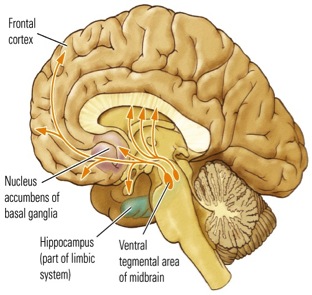
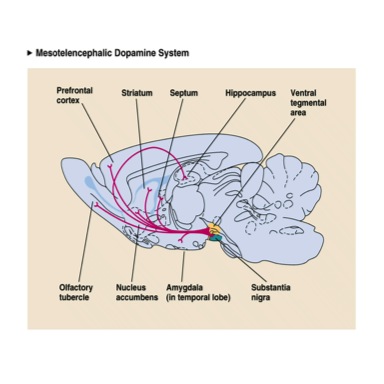 [A basic outline of the mesotelencephalic dopamine system in a human brain (left) versus a rat brain (right)]
[A basic outline of the mesotelencephalic dopamine system in a human brain (left) versus a rat brain (right)]
Addictive behavior is seen in a variety of animals, which shows that addictive behavior has been selected for in nature over time. Above on the left is a picture of a human brain and the right is a rat brain. These images show how similar in structure human brains are to other animals. Below is an image of just a few animals (and human) brains that all have very similar pleasure centers. All the brains can become addicted; therefore, by using different animals to study addiction scientists can focus on specific components of the behavior (such as hormonal responses or genetic effects). However, to look at the complexity of the behavior in general rhesus monkeys are used because they are the most similar in all components to humans.
Why has addiction been selected for through evolution?
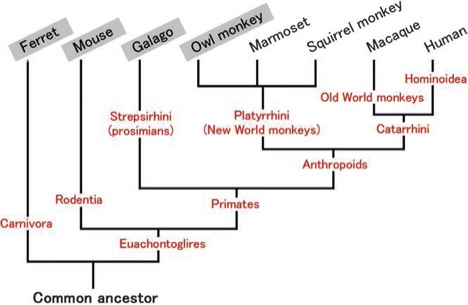
(Figure 1. above shows the relationship of primates, humans and other mammals)
Addiction is has been shown to be selected for through the similarities of brain circuitry and mechanisms in vertebrates and invertebrates. The mesolimbic dopamine system or the reward systems main function is to help learning in animals through motivational significance. This means that animals will be sent a signal when there is a fire that the fire is bad or too hot and the response will be to run away. Another example is of rats and their motivation to learn which substances are sweet and bitter to decide which they prefer.[26]
The structure of the reward-center of the brain is very useful for animals. Dopamine is released when animals eat, have sex, or learn. These actions are necessary for an animal’s survival and for the survival/creation of future generations. However, there has been selection for a more organized neural circuit in vertebrates.Bees
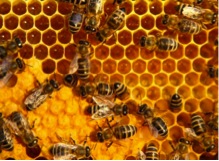
Andrew Barron performed a study of giving honeybees a dose of cocaine, octopamine, or a control chronically or for 6 days then none for 20 hours and considered it the withdrawal period. His results show that bees that have are withdrawn from cocaine are unable to perform the learning assay as well as the other treatments, and if the bees are chronically given cocaine they are able to perform better:
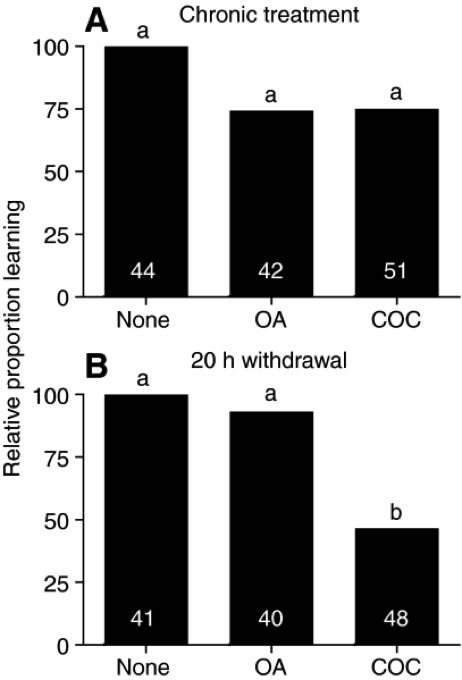
Figure 2. From Barron’s paper “Effects of cocaine on honey bee dance behavior”.
The graphs show data from honey bees that have been administered sucrose (None), octopamine (OA), or cocaine (COC) for 6 days. The top graph is data from a learning assay with bees on the drug after 6 daysof use and on the drugs during the test. The lower graph is of bees that are in 20 hours of withdrawl from the drug they were on. The bees that were continuously on drugs performed better because the brain iscontinuously being flooded with dopamine (for more information on how cocaine effects neurons and the brain see Ontogeny and Mechanism). While the withdrawl bees were 'coming down' from having excess dopamine to the regular levels. [24] The use of honey bees in studying the effects of cocaine on learning, aids researchers in better understanding how dopamine is used in reward-learning to create the good-feeling after the task is completed. [27]
Flies
Flies have about 75% of the same gene families as humans which makes it accessible to study certain diseases in flies to find cures. Flies are now also used to study addiction because their mechanisms of the brain as so similar to humans and because they are relatively cheap to maintain and multiple generations can be produced quickly unlike rhesus monkeys, that have an incubation period of about 165 days. [28][29]
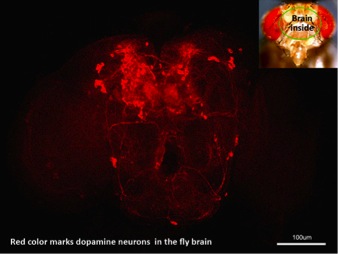
(The figure above is of a fly brain and the neon green dots represent active D1 receptors.)
The figure above is from a study that is trying to find a correlation between short term memory, long term memory, and learning with specific receptors in the brain. The researchers are creating mutants with one receptor ‘knocked out’ of the genes i.e. taking out the gene that creates/regulates the receptor, in hopes of finding the exact mechanism and genetic basis for addiction, diseases and learning disorders. The focus of the research will be testing the effects of cocaine and alcohol on the brain because they both change the way the reward circuitry in the brain work and how an animal behaves to see if a specific receptor is what is causing addiction to these substances.[29]
Why Rhesus monkeys are still a better model for studying human addiction
“Such ‘cognitive’ modulation of hormones is a distinctive feature of the human and primate brain: one witness advised that neuroendocrine findings derived from rodents can sometimes be misleading for human brain functions involving hormonal influences.”[25] Since rhesus monkeys are more similar to human brains in more than just structure by on a hormonal level as well, it is a much better representation of a possible human response to a stimulus.